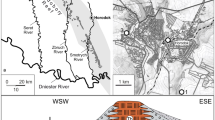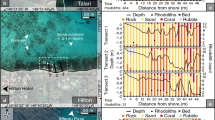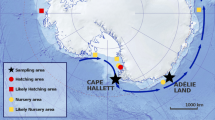Abstract
We evaluated the spatial and temporal scales over which otolith signatures varied in a reef fish on the Great Barrier Reef (GBR) using the non-dispersing damselfish Acanthochromis polyacanthus. We found a robust multi-element separation in otolith signatures from reef clusters in the northern and southern GBR. Variance components indicated that this spatial scale accounted for the majority of the variation in two elemental ratios (Ba/Ca and Sr/Ca) over the 2 years of the study. There was also significant variation in elemental signatures between otoliths collected over two consecutive years, as well as within a season. Individual reefs within clusters were less distinguishable based on otolith chemistry and were probably observed by differences within reefs (among sites and broods within sites). These results indicate that it may be difficult to determine the reef of origin for individual fish using otolith chemistry, while determining natal region seems a realistic goal.





Similar content being viewed by others
References
Alldredge AL, King JM (1977) Distribution, abundance, and substrate preferences of demersal reef zooplankton at Lizard Island Lagoon, Great Barrier Reef. Mar Biol 41:317–333
Bath GE, Thorrold SR, Jones CM, Campana SE, McLaren JW, Lam JWH (2000) Strontium and barium uptake in aragonite otoliths of marine fish. Geochim Cosmochim Acta 64:1705–1714
Brophy D, Jeffries TE, Danilowicz BS (2004) Elevated manganese concentrations at the cores of clupeid otoliths: possible environmental, physiological, and structural origins. Mar Biol 144:779–786
Burrage D, Hughes R, Bode L, Williams D (1995) Dynamic features and transports of the Coral Sea circulation. In: Bellwood O, Choat JH, Saxena N (eds) Recent advances in marine science and technology ’94. James Cook University, Townsville, pp 95–105
Campana SE (1999) Chemistry and composition of fish otoliths: pathways, mechanisms and applications. Mar Ecol Prog Ser 188:263–297
Campana SE, Fowler AJ, Jones CM (1994) Otolith elemental fingerprinting for stock discrimination of Atlantic cod (Gadus morhua) using laser ablation ICPMS. Can J Fish Aquat Sci 51:1942–1950
Campana SE, Gagne JA, McLaren JW (1995) Elemental fingerprinting of fish otoliths using ID-ICPMS. Mar Ecol Prog Ser 122:115–120
Campana SE, Chouinard GA, Hanson JM, Frechet A, Brattey J (2000) Otolith elemental fingerprints as biological tracers of fish stocks. Fish Res 46:343–357
Carleton JH, Brinkman R, Doherty PJ (2001) Zooplankton community structure and water flow in the lee of Helix Reef (Great Barrier Reef, Australia). Mar Biol 139:705–717
Church JA (1987) East Australian Current adjacent to the Great Barrier Reef. Aust J Mar Freshw Res 38:671–683
Doherty PJ, Kingsford MJ, Booth DJ, Carleton J (1996) Habitat selection before settlement by Pomacentrus coelestis. Mar Freshw Res 47: 391–399
Elsdon TS, Gillanders BM (2002) Interactive effects of temperature and salinity on otolith chemistry: challenges for determining environmental histories of fish. Can J Fish Aquat Sci 59:1796–1808
Gillanders BM (2002) Temporal and spatial variability in elemental composition of otoliths: implications for determining stock identity and connectivity of populations. Can J Fish Aquat Sci 59:669–679
Gillanders BM, Kingsford MJ (1996) Elements in otoliths may elucidate the contribution of estuarine recruitment to sustaining coastal reef populations of a temperate reef fish. Mar Ecol Prog Ser 141:13–20
Gillanders BM, Kingsford MJ (2000) Elemental fingerprints of otoliths may distinguish estuarine “nursery” habitats. Mar Ecol Prog Ser 201:273–286
Hamer PA, Jenkins GP, Gillanders BM (2003) Otolith chemistry of juvenile snapper Pagrus auratus in Victorian waters: natural chemical tags and their temporal variation. Mar Ecol Prog Ser 263:261–273
Kavanagh KD (1998) Notes on the frequency and function of glancing behavior in juvenile Acanthochromis (Pomacentridae). Copeia 1998:493–496
Kavanagh KD (2000) Larval brooding in the marine damselfish Acanthochromis polyacanthus (Pomacentridae) is correlated with highly divergent morphology, ontogeny and life-history traits. Bull Mar Sci 66:321–337
Kennedy BP, Blum JD, Folt CL, Nislow KH (2000) Using natural strontium isotopic signatures as fish markers: methodology and application. Can J Fish Aquat Sci 57:2280–2292
Kingsford MJ, Gillanders BM (2000) Variation in concentrations of trace elements in the otoliths and eye lenses of a temperate reef fish, Parma microlepis as a function of depth, spatial scale and age. Mar Biol 137:403–414
Kleypas JA, Burrage DM (1994) Satellite observations of circulation in the southern Great Barrier Reef, Australia. Int J Remote Sens 15:2051–2063
Lea DW, Shen GT, Boyle EA (1989) Coralline barium records temporal variability in equatorial Pacific upwelling. Nature 340:373–376
Leis JM (1991) The pelagic stage of reef fishes: The larval biology of coral reef fishes. In: Sale PF (ed) The ecology of fishes on coral reefs. Academic Press, San Diego, pp 183–230
Nakazono A (1993) One-parent removal experiment in the brood-caring damselfish Acanthochromis polyacanthus, with preliminary data on reproductive biology. Aust J Mar Freshw Res 44:699–707
Patterson HM (2003) Otolith chemistry, early life history, and potential self-recruitment of coral reef fishes. PhD Thesis, James Cook University, Townsville, Australia
Patterson HM, Thorrold SR, Shenker JM (1999) Analysis of otolith chemistry in Nassau grouper (Epinephelus striatus) from the Bahamas and Belize using solution-based ICP-MS. Coral Reefs 18:171–178
Patterson HM, Kingsford MJ, McCulloch MT (2004a) Elemental signatures of Pomacentrus coelestis at multiple spatial scales on the Great Barrier Reef, Australia. Mar Ecol Prog Ser 270:229–239
Patterson HM, Kingsford MJ, McCulloch MT (2004b) The influence of oceanic and lagoonal plume waters on otolith chemistry. Can J Fish Aquat Sci 61:898–904
Pentreath RJ (1976) Some further studies on the accumulation and retention of 65 Zn and 55 Mn by the plaice, Pleuronectes platessa L. J Exp Mar Biol Ecol 21:179–189
Planes S, Doherty PJ, Bernardi G (2001) Strong genetic divergence among populations of a marine fish with limited dispersal, Acanthochromis polyacanthus, within the Great Barrier Reef and the Coral Sea. Evolution 55:2263–2273
Quinn GP, Keough MJ (2002) Experimental design and data analysis for biologists. Cambridge University Press, Cambridge
Robertson DR (1973) Field observations on the reproductive behavior of a pomacentrid fish, Acanthochromis polyacanthus. Z Tierpsychologie 32:319–324
Stecher HA, Kogut MB (1999) Rapid barium removal in the Delaware estuary. Geochim Cosmochim Acta 63:1003–1012
Swearer SE, Caselle JE, Lea DW, Warner RR (1999) Larval retention and recruitment in an island population of a coral-reef fish. Nature 402:799–802
Swearer SE, Forrester GE, Steele MA, Brooks AJ, Lea DW (2003) Spatio-temporal and interspecific variation in otolith trace-elemental fingerprints in a temperate estuarine fiss assemblage. East Coast Shelf Sci 56:1111–1123
Thorrold SR, Jones CM, Campana SE, McLaren JW, Lam JWH (1998a) Trace element signatures in otoliths record natal river of juvenile American shad (Alosa sapidissima). Limnol Oceanogr 43:1826–1835
Thorrold SR, Jones CM, Swart PK, Targett TE (1998b) Accurate classification of juvenile weakfish (Cynoscion regalis) to estuarine nursery areas based on chemical signatures in otoliths. Mar Ecol Prog Ser 173:253–265
Thorrold SR, Latkoczy C, Swart PK, Jones CM (2001) Natal homing in a marine fish metapopulation. Science 291:297–299
Thorrold SR, Jones GP, Hellberg ME, Burton RS, Swearer SE, Neigel JE, Morgan SG, Warner RR (2002) Quantifying larval retention and connectivity in marine populations with artificial and natural markers. Bull Mar Sci 70(Suppl):291–308
Thresher RE (1985) Distribution, abundance, and reproductive success in the coral reef fish Acanthochromis polyacanthus. Ecology 66:1139–1150
Thresher RE, Proctor CH, Gunn JS, Harrowfield IR (1994) An evaluation of electron-probe microanalysis of otoliths for stock delineation and identification of nursery areas in a southern temperate groundfish, Nemadactylus macropterus (Cheilodactylidae). Fish Bull 92:817–840
Underwood AJ (1997) Experiments in ecology: their logical design and interpretation using analysis of variance. Cambridge University Press, Cambridge
Wilson SG, Carleton JH, Meekan MG (2003) Spatial and temporal patterns in the distribution and abundance of macrozooplankton on the southern North West Shelf, Western Australia. East Coast Shelf Sci 56:897–908
Acknowledgements
We thank J. Browne, I. Carlson, S. Burgess, J. Eagle, J. Hughes, A. Abdulla, R. Pears, R. Kelley, and the crew of the M.V. James Cook for assistance in the field. We also thank the staff of the One Tree Island and Lizard Island Research Stations for their assistance and for providing temperature data. Y. Hu provided technical advice and assistance with ICP-MS analyses. Statistical advice was provided by M. Sheaves, B. Gillanders and N. Knott. We thank S. Swearer and several anonymous reviewers for comments on the manuscript. This study was conducted while H.M.P. held a Lizard Island Doctoral Fellowship from the Australian Museum. A CRC Reef Research Grant, a GBRMPA Augmentative Research Grant, and a grant from the Lerner-Gray Fund for Marine Research from the American Museum of Natural History to H.M.P., as well as an ARC Large Grant, and a grant from the National Geographic Committee for Research & Exploration to M.J.K. provided additional funding.
Author information
Authors and Affiliations
Corresponding author
Additional information
Communicated by Ecological Editor P. Sale
Rights and permissions
About this article
Cite this article
Patterson, H.M., Kingsford, M.J. Elemental signatures of Acanthochromis polyacanthus otoliths from the Great Barrier Reef have significant temporal, spatial, and between-brood variation. Coral Reefs 24, 360–369 (2005). https://doi.org/10.1007/s00338-005-0012-6
Received:
Accepted:
Published:
Issue Date:
DOI: https://doi.org/10.1007/s00338-005-0012-6




